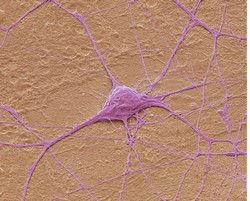Analysis of axonal transport in motor neurons
Neurons have an intrinsic capacity to propagate signals over long distances down their axons or dendrites. Due to their specialised morphology, they developed a specific long-range communication process between the soma and distal synapses: the fast axonal transport. Specialised vesicles called signalling endosomes carry out retrograde axonal transport from the synapses towards the cell body. These vesicles convey neuronal growth and differentiation factors, or neurotrophins, thereby regulating neuronal physiology and survival. Emerging evidence indicates a link between axonal transport deficit and neurodegeneration, emphasising further the clinical importance of these vesicles. Nonetheless, there is very little information on their dynamics and identity. In answer to this, scientists on the EU-funded AXOTRANSMAP (Assembling a functional map of axonal signalling endosomes) project set out to characterise the molecular content of the neuronal signalling endosomes and delineate the mechanism of their regulation. To achieve this, they developed a strategy using a fragment of the tetanus neurotoxin conjugated to ferromagnetic beads. Since the neurotoxin beads complexes get transported in signalling endosomes, scientists used magnetic isolation to purify these vesicles. The work was performed in motor neurons derived from embryonic stem cells, and the isolated endosomes were analysed for their molecular composition and dynamic changes during transport. Results showed a fast and progressive maturation of signalling endosomes with time, via the recruitment of specific proteins. Strikingly, researchers discovered that endosomes were specifically enriched in proteins known to be involved in neurodegeneration and infection of the central nervous system. The AXOTRANSMAP quantitative analysis of the proteins contained in motor neuron signalling endosomes, apart from fundamental knowledge, opens avenues towards the identification of novel reliable biomarkers for neurodegenerative disorders. Considering the increase in the ageing population and the incidence of neurodegenerative disorders, this information could lead to novel therapeutic approaches.







